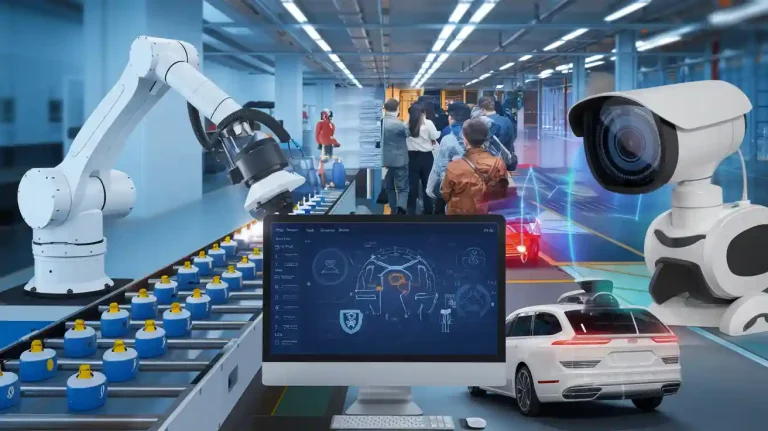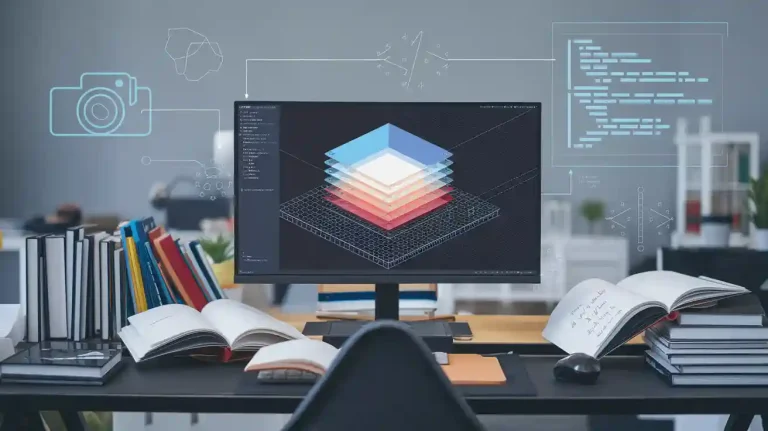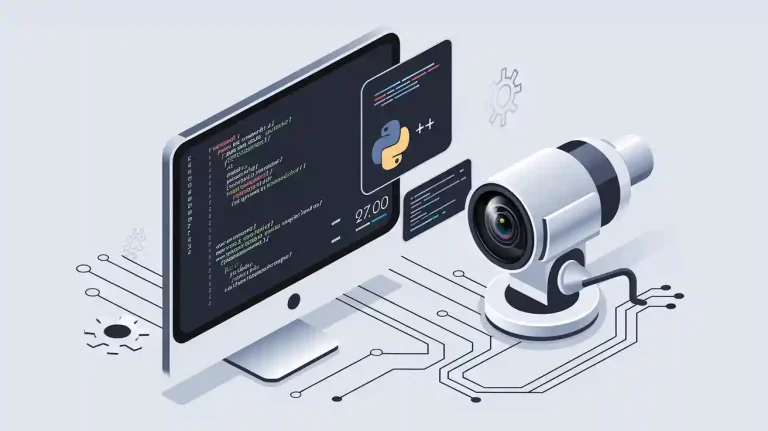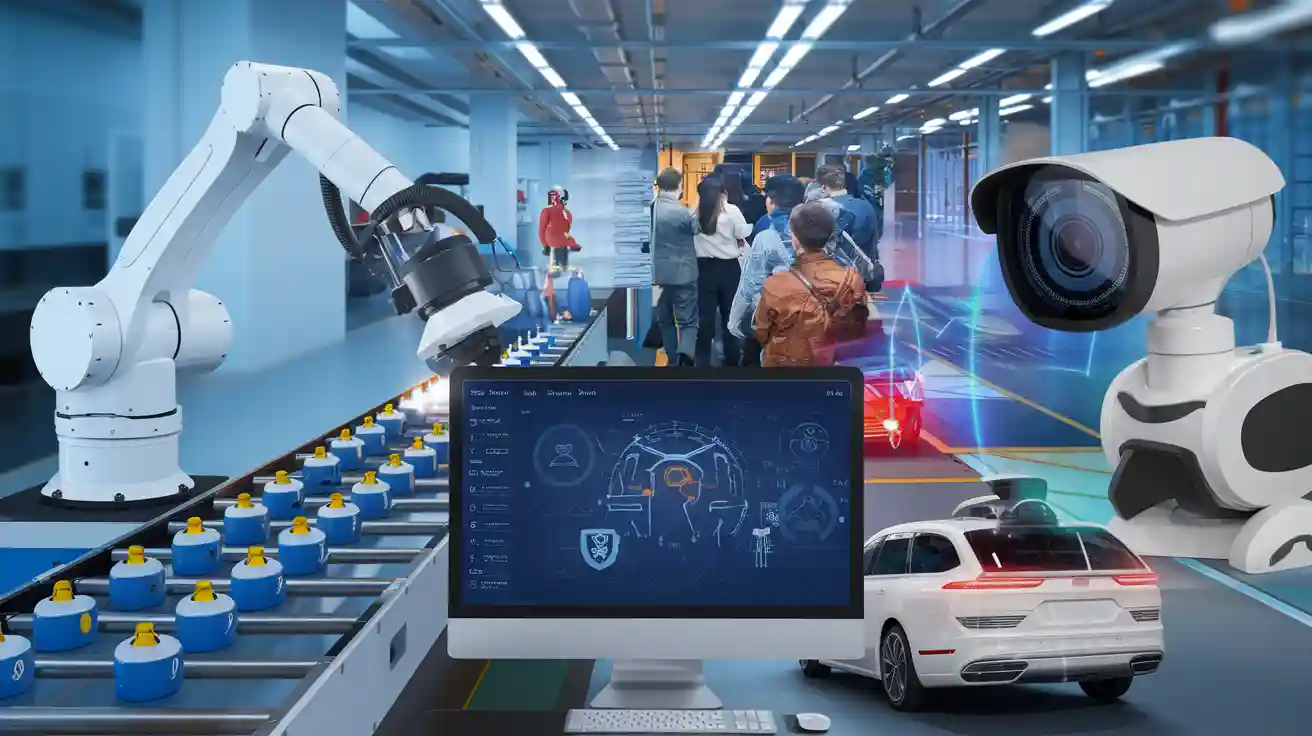
Machine vision systems help factories, hospitals, and logistics centers solve real-world problems every day. These systems check product quality, guide robots, and track items using computer vision. Many industries rely on Applications and Use Cases machine vision system to spot flaws, identify objects, and speed up operations. Machine vision systems support many applications, from sorting food to inspecting electronics. Businesses use machine vision systems to improve accuracy and reduce errors.
Key Takeaways
- Machine vision systems improve product quality by detecting defects early and reducing errors across many industries.
- These systems speed up processes like identification, inspection, and robot guidance, making production lines more efficient.
- Machine vision supports safety and accuracy in automotive, healthcare, logistics, and security applications.
- Automation with machine vision lowers costs, reduces waste, and helps companies deliver better products faster.
- Advances in AI and machine vision continue to open new possibilities for smarter, more reliable systems in the future.
Applications and Use Cases Machine Vision System
Machine vision systems support a wide range of applications and use cases machine vision system across many industries. These systems help companies automate inspection, identification, and guidance tasks. They use computer vision and image recognition to check products, guide robots, and track items on the production line. The following sections explain how vision inspection systems improve production and reduce errors in real-world settings.
Quality Inspection
Quality inspection stands as one of the most important applications and use cases machine vision system. Companies use machine vision systems to check products for defects and ensure high standards on every production line. These systems can spot tiny cracks, color changes, or missing parts that humans might miss.
- In semiconductor and MEMS manufacturing, machine vision systems classify defects automatically. This process reduces labor costs and makes workflows faster.
- Food and beverage production lines use machine vision to monitor the appearance and color of products, such as pizza mix. This helps keep the final product consistent and high-quality.
- Automotive factories rely on machine vision to find defects in camshafts, brake pads, and brake discs early. Early detection prevents expensive rework or scrapping.
- Medical device makers use machine vision to check for contamination and improper seals in sterile packaging for surgical tools, heart valves, ventilators, and stents.
- Some factories use machine vision to track worker movements and cycle times. This ensures workers follow standard processes and helps find the root cause of quality problems.
Machine vision systems make quality inspection faster, more accurate, and less expensive. They help companies deliver safe and reliable products to customers.
Automated Identification
Automated identification is another key area for applications and use cases machine vision system. On the production line, machine vision systems read barcodes, QR codes, and labels at high speed. This process supports traceability and inventory management.
- Factories use automated issue identification to spot mislabeled or misplaced items.
- In logistics, machine vision systems track packages as they move through the supply chain.
- Automated identification also helps with access control and security by recognizing faces or badges.
These systems work quickly and do not get tired, so they keep production moving smoothly.
Robotics Guidance
Robotics guidance uses machine vision systems to direct robots on the production line. Robots need to know where to pick up, place, or assemble parts. Machine vision gives robots the "eyes" they need to see and understand their environment.
- In automotive assembly, robots use machine vision to align parts with high precision.
- Electronics factories use robots guided by machine vision to place tiny components on circuit boards.
- In packaging, robots sort and pack products based on size, shape, or color.
This guidance improves speed and accuracy, making production lines more efficient.
Defect Reduction
Defect reduction is a major benefit of applications and use cases machine vision system. By catching problems early, machine vision systems help companies lower the number of defective products that reach customers.
- On the production line, machine vision systems check each item for defects before it moves to the next stage.
- They support automated issue identification, so workers can fix problems right away.
- Fewer defects mean less waste, lower costs, and happier customers.
Companies that use machine vision systems for defect reduction see better product quality and stronger reputations in the market.
Machine Vision in Manufacturing
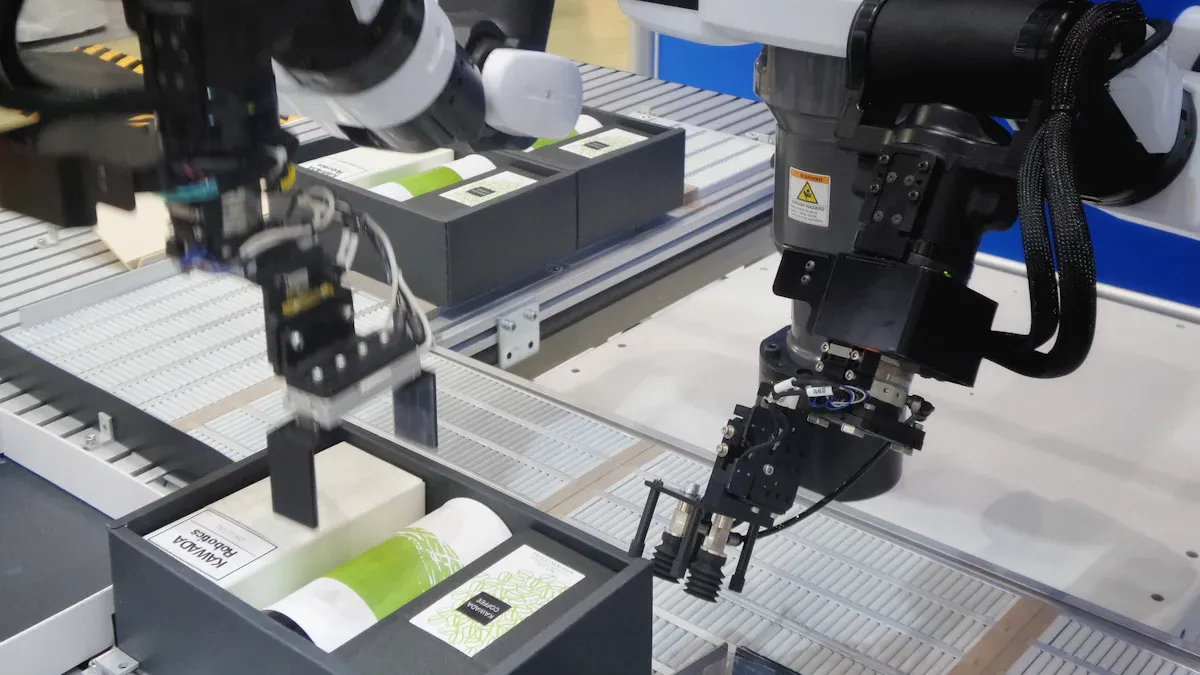
Manufacturers use machine vision in manufacturing to improve every step of production. These systems help companies check quality, guide product and component assembly, and keep production lines running smoothly. Machine vision in manufacturing supports Industry 4.0 by making factories smarter and more connected. Companies like BMW, Philips, and Toyota have seen fewer defects and better efficiency after using these systems.
Assembly Verification
Assembly verification uses machine vision in manufacturing to make sure every product and component assembly is correct. Cameras check if each part is in the right place on the production line. If a part is missing or in the wrong spot, the system alerts workers right away.
- Robots use machine vision to guide product and component assembly with high accuracy.
- This process reduces errors and keeps production moving fast.
Assembly verification helps companies avoid costly mistakes and deliver safe products.
Predictive Maintenance
Predictive maintenance uses machine vision in manufacturing to watch machines and spot problems before they cause breakdowns. Cameras and sensors check equipment health during production. Companies like Siemens and Caterpillar use this technology to reduce downtime and save money.
- Machine vision systems find small issues early, so workers can fix them before they stop the production line.
- These systems help companies plan repairs, lower waste, and keep production steady.
Predictive maintenance leads to longer machine life and better efficiency.
Packaging Inspection
Packaging inspection is another important use of machine vision in manufacturing. Cameras check every package on the production line for correct labels, seals, and barcodes. This step keeps products safe and ready for shipping.
- Machine vision systems spot damaged or mislabeled packaging quickly.
- Companies use packaging inspection to meet safety rules and keep customers happy.
Good packaging inspection means fewer returns and better product quality.
Flaw Detection
Flaw detection uses machine vision in manufacturing to find defects that humans might miss. Systems scan each item on the production line for cracks, scratches, or color changes. Companies like General Electric and Rolls-Royce use this technology to keep quality high.
- Flaw detection helps reduce waste and improve efficiency.
- Early detection means fewer bad products reach customers.
Machine vision in manufacturing makes production lines smarter, faster, and more reliable.
Automotive and Logistics
Autonomous Vehicles
Autonomous vehicles use machine vision systems to see the road and make decisions. Cameras and sensors help these vehicles detect traffic signs, lane markings, and other cars. The system uses real-time recognition to spot obstacles and keep passengers safe. Many companies test self-driving cars in cities and on highways. These vehicles can help reduce accidents and improve traffic flow.
Machine vision gives autonomous vehicles the ability to react quickly to changes on the road.
Driver Assistance
Modern cars use machine vision for driver assistance features. These systems warn drivers about lane departures or help with parking. Some cars can even brake automatically if they sense danger ahead. Machine vision helps drivers stay alert and avoid accidents. It also supports adaptive cruise control, which keeps a safe distance from other vehicles.
- Lane keeping
- Automatic emergency braking
- Traffic sign detection
These features make driving safer and more comfortable.
Parts Inspection
Automotive factories use machine vision to inspect parts during production. Cameras check each part for defects, such as cracks or missing pieces. This process ensures that only high-quality parts go into vehicles. Machine vision systems work faster than humans and do not get tired. They help factories keep up with high production demands.
Reliable parts inspection leads to safer cars and fewer recalls.
Supply Chain Tracking
Logistics companies rely on machine vision for supply chain tracking. The system can scan barcodes and labels on packages as they move through warehouses. This helps companies track and trace every item from the factory to the customer. Machine vision speeds up sorting and reduces mistakes. It also helps companies find lost items quickly.
| Application | Benefit |
|---|---|
| Supply chain tracking | Faster delivery, fewer errors |
| Parts inspection | Better quality, safer vehicles |
Machine vision systems play a key role in automotive and logistics by improving safety, speed, and accuracy in production and delivery.
Healthcare and Food Processing
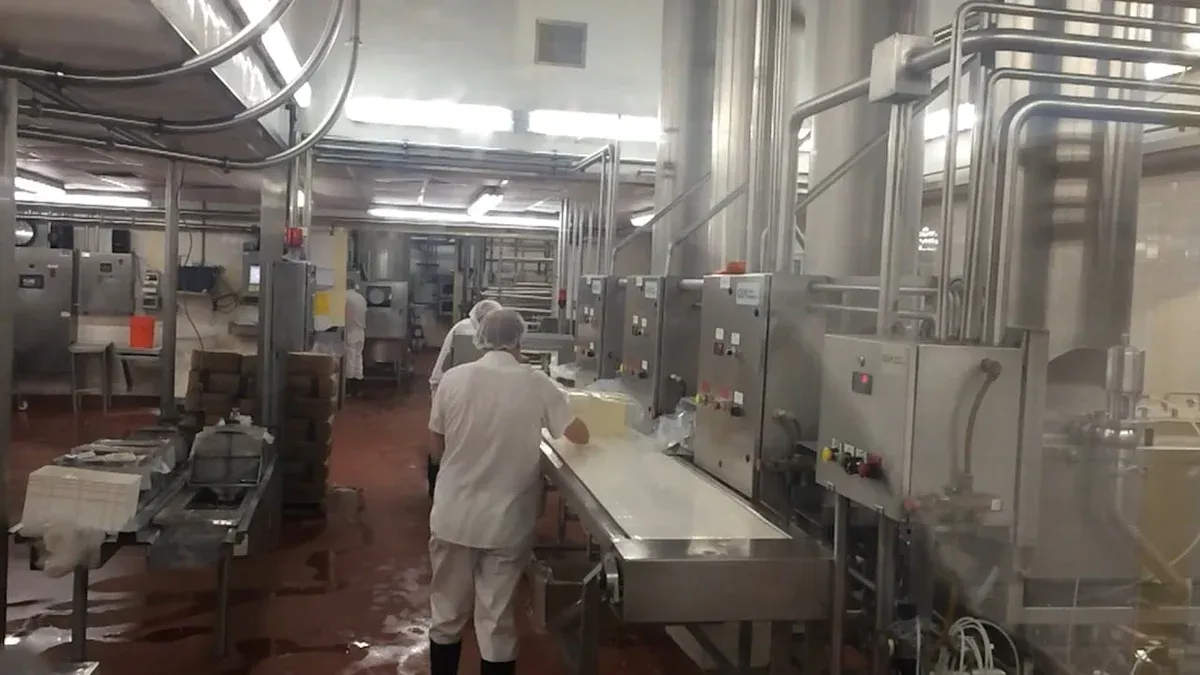
Diagnostic Imaging
Machine vision systems have transformed diagnostic imaging in hospitals and clinics. These systems use artificial intelligence and deep learning to help doctors see more details in medical images.
- They optimize image acquisition protocols, which reduces scan times and lowers patient radiation exposure.
- AI algorithms improve image quality by reducing noise and artifacts, making it easier to spot problems.
- Automation of routine tasks, such as image normalization and segmentation, speeds up the interpretation process.
- The system can flag abnormal findings, helping radiologists focus on urgent cases.
- Convolutional neural networks detect lesions and classify conditions with high precision, supporting early disease detection.
- Radiomics with AI extracts features beyond human sight, aiding personalized treatment planning.
- AI reconstructs high-quality images from low-dose scans, especially in PET and CT imaging.
- Integration with electronic health records and automated reporting tools accelerates report generation and reduces manual work.
Machine vision in diagnostic imaging leads to faster, more accurate diagnoses and improves patient care.
Laboratory Automation
Laboratories use machine vision to automate many tasks. These systems identify and sort samples, track test tubes, and check for errors during production. Automation reduces human mistakes and speeds up workflows. Machine vision also helps labs handle large numbers of samples, which is important for hospitals and research centers. By using these systems, labs can deliver results faster and with greater accuracy.
Sorting and Grading
Food processing plants rely on machine vision for sorting and grading. These systems inspect products for defects, color, texture, shape, and contamination. Experts note that AI-based vision systems are easier to train for complex inspection tasks, especially with the variability in food appearance. The technology captures images and compares them to quality standards, ensuring only the best products move forward in production. System integrators address challenges like integrating with existing lines and handling different types of food. Machine vision now grades vegetables, inspects meat for contaminants, and checks packaging for defects, improving quality control across the industry.
| Benefit Description | Measurable Impact |
|---|---|
| Reduction in false rejects | Weekly false rejects dropped from 12,000 to 246 units, saving over $18 million annually per line |
| Inspection speed | Vision-guided robots process up to 10,000 parts per hour |
| Labor cost reduction | About 50% reduction in quality assurance labor |
| Accuracy improvement | Over 99.5% accuracy in defect detection |
| Classification accuracy increase | 20% improvement over traditional algorithms |
| Productivity gains | Over 40% improvement in robotic part-picking efficiency |
| Sustainability benefits | 38% reduction in energy use and CO2 emissions |
| Workplace safety | Automation reduces manual inspection in hazardous areas |
Contaminant Detection
Machine vision systems play a key role in contaminant detection during food production. Cameras scan products for foreign objects, such as glass, metal, or plastic. The system removes contaminated items before they reach consumers. This process protects public health and helps companies meet safety standards. Machine vision also checks for allergens and ensures proper labeling, which is vital for safe food packaging.
Security and Surveillance
Facial Recognition
Facial recognition uses machine vision to identify people by their faces. Security teams use this technology in airports, stadiums, and office buildings. Cameras capture images of faces as people enter a space. The system compares these images to a database of known faces. If the system finds a match, it alerts security staff.
- Airports use facial recognition to speed up check-in and boarding.
- Schools use it to track attendance and keep students safe.
- Businesses use it to protect sensitive areas.
Facial recognition helps prevent unauthorized access and improves public safety.
Intrusion Detection
Intrusion detection systems use machine vision to spot people or objects entering restricted areas. Cameras watch doors, fences, and other entry points. The system detects movement and checks if the activity is normal. If someone enters a secure area without permission, the system sends an alert.
- Banks use intrusion detection to protect vaults.
- Warehouses use it to guard valuable inventory.
- Homes use it to keep families safe.
Machine vision systems work day and night. They do not get tired or distracted.
Access Control
Access control uses machine vision to decide who can enter a building or room. The system checks faces, badges, or even fingerprints. Only approved people can enter.
- Hospitals use access control to protect patient records.
- Data centers use it to secure computer rooms.
- Factories use it to limit entry to dangerous areas.
| Application Area | Machine Vision Role | Benefit |
|---|---|---|
| Hospitals | Face/badge verification | Patient privacy |
| Data Centers | Biometric access | Data security |
| Factories | Restricted area monitoring | Worker safety |
Machine vision in access control keeps people and information safe. It gives organizations better control over who enters important spaces.
Machine vision systems show great versatility across industries. They improve quality, speed, and safety in manufacturing, healthcare, logistics, and security.
- Many companies now use machine vision to solve real problems and boost efficiency.
- New advances appear every year, opening more possibilities for the future.
Readers can explore how machine vision might solve challenges in their own fields. Staying informed about new trends helps everyone make better decisions.
FAQ
What industries use machine vision systems the most?
Manufacturing, automotive, logistics, healthcare, and food processing use machine vision systems the most. These industries rely on vision technology to improve quality, speed, and safety in their daily operations.
How do machine vision systems help reduce errors?
Machine vision systems check products and processes with high accuracy. They spot defects, missing parts, or wrong labels quickly. This reduces human mistakes and helps companies deliver better products.
Can machine vision systems work in low light?
Many machine vision systems use special cameras and lighting. These tools help the system see clearly, even in low-light or dark areas. This makes them useful in many different environments.
Are machine vision systems expensive to install?
The cost depends on the system’s complexity and the application. Some basic systems are affordable for small businesses. Larger, advanced systems may cost more but often save money by reducing waste and improving efficiency.
What is the future of machine vision technology?
Experts expect machine vision to become smarter with artificial intelligence. Systems will learn faster and handle more complex tasks. Many industries will see new uses for machine vision as technology advances.
See Also
Essential Features And Advantages Of Machine Vision In Medical Devices
Understanding The Role Of Cameras In Machine Vision Systems
Comparing Firmware-Based Machine Vision With Conventional Systems
Defining Automotive Machine Vision Systems And Their Functions
Exploring Computer Vision Models And Their Use In Machine Vision







